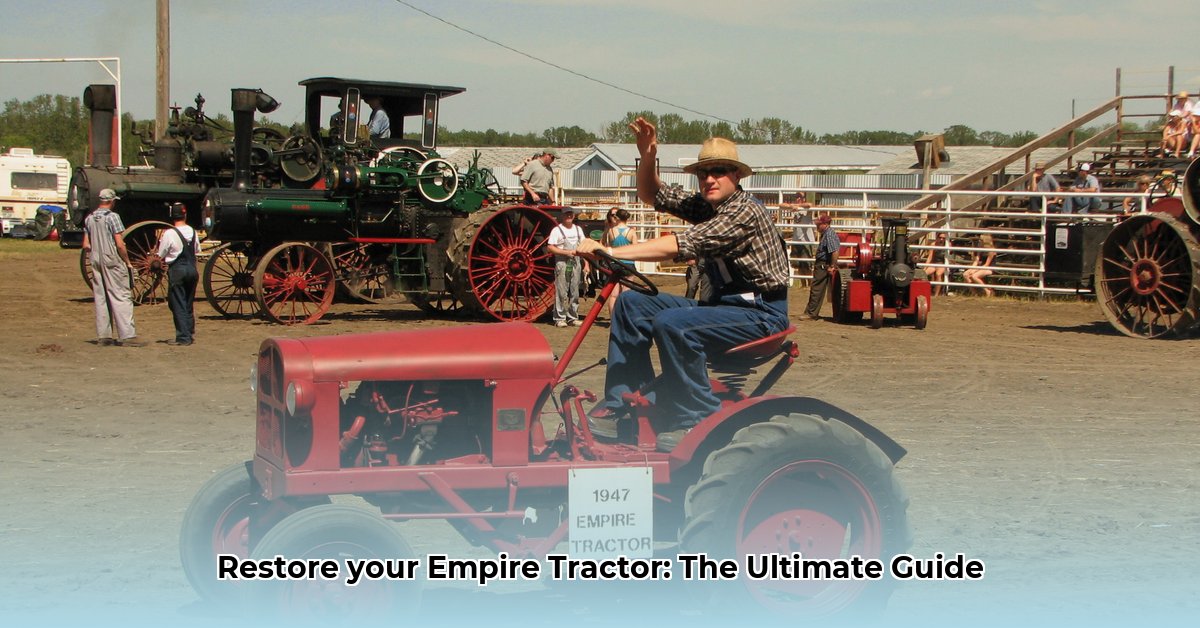
Empire Tractors: A Resurgence of History
Bringing a vintage Empire tractor back to life is a rewarding blend of historical detective work and hands-on mechanical skill. Manufactured between 1946 and 1950, these machines stand out for their ingenious use of readily available Willys Jeep parts, a testament to post-war ingenuity. However, this cost-saving measure, combined with some design limitations, resulted in a relatively short production run, making restoration today a unique challenge. For more information on Empire Tractors, visit the Empire Tractor Owners Club. This guide navigates you through the process, from initial assessment to the satisfying roar of a restored engine. Are you ready to embark on this journey?
Unearthing the Past: A Historical Perspective
Before you even consider a wrench, understanding the history of your Empire tractor enriches the restoration experience. These weren't just machines; they were integral to the post-war agricultural landscape, embodying the resourcefulness of a nation rebuilding. Their design, while innovative for its time, presented limitations. Higher-than-anticipated production costs and early design flaws impacted sales, ultimately contributing to the scarcity of parts today. Understanding this historical context—from wartime origins to its eventual decline—elevates the restoration from a mechanical task to a journey of preservation. How many of these tractors do you think exist today? (A reliable estimate is difficult, but fewer than 100 are believed to be fully restorable.)
Assessing Your Tractor: A Comprehensive Evaluation
Before starting the restoration, conduct a thorough assessment of your Empire tractor. Consider it a crucial pre-operative examination. Photograph everything meticulously, documenting every detail. Examine the chassis for structural integrity. Assess the engine: can the crankshaft be turned manually? Is it seized? Evaluate the transmission: does it shift properly? Create a detailed inventory of needed repairs. This comprehensive analysis determines your strategy and project scope, providing a clearer estimate of the time, effort, and cost involved. Don't get discouraged by the seeming complexity; it's a rewarding journey!
The Parts Pursuit: Sourcing Components
Finding parts for an Empire tractor represents a significant hurdle. The limited production run means original parts are exceedingly rare. What's your approach? Begin with local salvage yards; you'll be amazed at what's tucked away. Online forums dedicated to classic tractor restoration (and the Empire Tractor Owners Club) are invaluable resources. Networking with other enthusiasts is key – the sharing of knowledge and parts is common in these communities. Replication may be necessary, but expect added costs.
Step-by-Step Restoration: A Practical Guide
The restoration is a systematic process, similar to assembling a complex puzzle. Safety remains paramount; always prioritize precautions.
- Disassembly: Carefully disassemble your tractor, meticulously documenting each step and carefully storing each component. Clear labeling is crucial for reassembly.
- Deep Cleaning: Thoroughly clean all parts, removing rust, grime, and debris. Utilize methods appropriate to each component, from simple scrubbing to professional media blasting for stubborn rust.
- Repair & Replacement: Using your assessment and acquired parts, begin the repair process.
- Reassembly: Methodically reassemble your tractor. Use diagrams and manuals whenever possible.
- Testing & Fine-Tuning: After reassembly, rigorously test each system, including engine break-in and transmission operation.
Troubleshooting: Addressing Common Challenges
Expect to encounter problems during restoration. Engine overheating, often stemming from cooling system leaks, is common. Transmission problems, like worn gears, might require component replacement. Remember, these are typical challenges addressed by experienced restorers. Community forums and the Empire Tractor Owners Club are excellent sources for solutions.
Safety First: Essential Precautions
Working with older machinery inherently involves risks. Always wear appropriate safety gear: gloves, eye protection, hearing protection, and sturdy work boots. Use jack stands correctly. Never work under a raised tractor without secure support. Prioritize safety; a safe restoration is a successful restoration.
The Gratifying Conclusion: An Empire Reborn
Restoring an Empire tractor is demanding, but immensely rewarding. It's more than simply fixing a machine; you're preserving a piece of agricultural history. The satisfaction of a job well done, marked by the revived tractor, is truly unparalleled. And that initial roar of the engine? Priceless. What other classic tractors might you consider restoring in the future? (Many enthusiasts move on to other makes and models after successfully restoring an Empire.)
Key Takeaways: A Summary of Essential Points
- Join the Empire Tractor Owners Club: This community is a goldmine of information and parts for your project.
- Parts Sourcing is Key: Be prepared for a challenging search, encompassing salvage yards, online forums, and potential reproduction.
- Safety is Paramount: Always prioritize safety when working on an antique machine with potentially dangerous components.